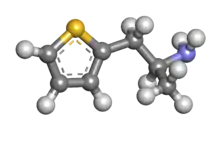 | |
 | |
| Legal status | |
|---|---|
| Legal status |
|
| Identifiers | |
| |
| CAS Number | |
| PubChem CID | |
| ChemSpider | |
| UNII | |
| ChEMBL | |
| CompTox Dashboard (EPA) | |
| Chemical and physical data | |
| Formula | C7H11NS |
| Molar mass | 141.23 g·mol−1 |
| 3D model (JSmol) | |
| |
| |
| (verify) | |
Thiopropamine is a stimulant drug which is an analogue of amphetamine where the phenyl ring has been replaced by thiophene. It has similar stimulant effects to amphetamine but with around one third the potency. The N-methyl and thiophen-3-yl analogues are also known and are somewhat more potent, though still generally weaker than the corresponding amphetamines.[1][2]
Pharmacology
Like amphetamine and most of its analogues, thiopropamine most likely is a norepinephrine–dopamine reuptake inhibitor and/or releasing agent.
Thiopropamine is likely to be metabolized into active 4-hydroxymethiopropamine and thiophene S-oxides.[3][4] These are further deaminated by CYP2C in liver transforming them into inactive 1-(Thiophen-2-yl)-2-propan-2-one which is a phenylacetone derivative.[5] Propan-2-amines are not metabolized by monoamine oxidases and most actually behave as competitive monoamine oxidase inhibitors.[6][7]
References
- ↑ Alles GA, Feigen GA (July 1941). "Comparative Physiological Actions of Phenyl-, Thienyl- and Furylisopropylamines". Journal of Pharmacology and Experimental Therapeutics. 72 (3): 265–75.
- ↑ Campaigne E, McCarthy WC (September 1954). "3-Substituted Thiophenes. VIII. 3-Thienylalkylamines". Journal of the American Chemical Society. 76 (17): 4466–4468. doi:10.1021/ja01646a054.
- ↑ Treiber A, Dansette PM, El Amri H, Girault JP, Ginderow D, Mornon JP, Mansuy D (February 1997). "Chemical and Biological Oxidation of Thiophene: Preparation and Complete Characterization of Thiophene S-Oxide Dimers and Evidence for Thiophene S-Oxide as an Intermediate in Thiophene Metabolism in Vivo and in Vitro". Journal of the American Chemical Society. 119 (7): 1565–1571. doi:10.1021/ja962466g.
- ↑ Dansette PM, Thang DC, el Amri H, Mansuy D (August 1992). "Evidence for thiophene-S-oxide as a primary reactive metabolite of thiophene in vivo: formation of a dihydrothiophene sulfoxide mercapturic acid". Biochemical and Biophysical Research Communications. 186 (3): 1624–30. doi:10.1016/S0006-291X(05)81594-3. PMID 1510686.
- ↑ Yamada H, Shiiyama S, Soejima-Ohkuma T, Honda S, Kumagai Y, Cho AK, et al. (February 1997). "Deamination of amphetamines by cytochromes P450: studies on substrate specificity and regioselectivity with microsomes and purified CYP2C subfamily isozymes". The Journal of Toxicological Sciences. 22 (1): 65–73. doi:10.2131/jts.22.65. PMID 9076658.
- ↑ Mantle TJ, Tipton KF, Garrett NJ (September 1976). "Inhibition of monoamine oxidase by amphetamine and related compounds". Biochemical Pharmacology. 25 (18): 2073–7. doi:10.1016/0006-2952(76)90432-9. PMID 985546.
- ↑ Miller HH, Shore PA, Clarke DE (May 1980). "In vivo monoamine oxidase inhibition by d-amphetamine". Biochemical Pharmacology. 29 (10): 1347–54. doi:10.1016/0006-2952(80)90429-3. PMID 6901611.